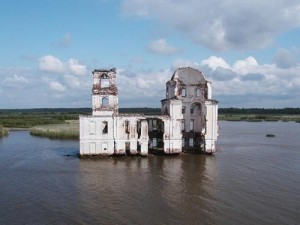The tale of Mologa is singularly odd … as well as tragic … even in the always odd and periodically tragic domain of the lost.
Things, as you are more than aware – especially if you’ve been following this little series – go missing. Paintings, books, films, people … just a little bit of research brings up a remarkable catalog of lost treasures. Some, like the legendary Amber Room, make a twisted kind of sense in their absence: an entire room covered in priceless amber and gold? Surprised it didn’t vanish long before World War 2.
Meanwhile those three novels by Philip K. Dick, King Kong Appears In Edo … and too many others like them … probably just got misplaced somewhere. While things, like Lake Peigneur in Louisiana, may have vanished but then reappeared totally transformed.
Then there’s Mologa. What makes this Russian city odd even among all these oddities is that it still exists: we know exactly where it is … in fact you can even visit it … but that doesn’t mean it’s actually there.
But first, a bit of background: founded sometime in the 12th century in Yaroslavl Oblast, Russia, after a few hundred years – and a history as twisted and convoluted as only a Russian city can have – Mologa, eventually became a key destination on the all-important Asian trade routes.
Even after the – and here’s an understatement – “Time of Troubles” (1598 to 1613) Mologa kept it’s trade importance and, by the 19th century, it had graduated to a valuable link between the Baltic and the Volga River.
 Then came Stalin. Uncle Joe had big plans for that region – including the creation of what would become the massive Rybinsk reservoir. How massive? Well, at the time of its creation in 1935 – with it being finally completed filling in 1947 – the Rybinsk reservoir was the largest artificial lake anywhere on Earth. That big.
Then came Stalin. Uncle Joe had big plans for that region – including the creation of what would become the massive Rybinsk reservoir. How massive? Well, at the time of its creation in 1935 – with it being finally completed filling in 1947 – the Rybinsk reservoir was the largest artificial lake anywhere on Earth. That big.
The problem for Joe was that there were a few —to him – little things in the way: mainly the residents of a few little villages. Like said: few to him. To the rest of us 663 communities sure does sound like a lot.
And, as you probably have already guessed, the entire population of Mologa … all 130,000 of them.
One simply doesn’t say ‘no’ to Stalin … and stay alive, that is. So all of those villagers were relocated elsewhere as their homes – as well as the long and noble history of Mologa – was submerged.
Mologa is still there – and even a few structures recently appeared from the depths of the Rybinsk reservoir after a particularly hot summer caused the waters to retreat: among them the ruins of Mologa’s Cathedral of the Epiphany.
 As reported by the BBC, Nikolai Novotelnov, who had lived in Mologa when he was a teenager reminisced forlornly about revisiting the rare reappearance of his old home: “Here was the inn, over there was the Voikov school and the flour store. Communist Street ran that way, towards the district administration building, the chemists, and my house.”
As reported by the BBC, Nikolai Novotelnov, who had lived in Mologa when he was a teenager reminisced forlornly about revisiting the rare reappearance of his old home: “Here was the inn, over there was the Voikov school and the flour store. Communist Street ran that way, towards the district administration building, the chemists, and my house.”
However, the additional heartbreak around the sinking of Mologa has only recently been officially recognized. For the longest time, and under Stalin’s rule it has come to be expected, it was a subject that simply wasn’t discussed … that officially never happened.
You never said ‘no’ to Iron Joe – but 294 residents of Mologa did just that: refusing the relocation order they, instead, stayed in their homes … as the waters of the Rybinsk reservoir rose steadily higher.
In 2003 a monument was erected on the shores of the reservoir and every April 14th, a service is held near what few remains of the city that were not completedly submerged … a service and monument to remember those residents of Mologa who refused to leave, and who paid the price for refusing Stalin’s orders:
They drowned.
Mologa has vanished, but yet it remains: a few ghostly fragments of architecture that peer above the waters of the Rybinsk reservoir and, every few decades when it recedes, those few other structures that emerge.
But, in some small consolation, even though the city no longer exists it – and the noble souls who gave their lives to stay in their homes – it still remains: lost, perhaps, but not entirely gone.










